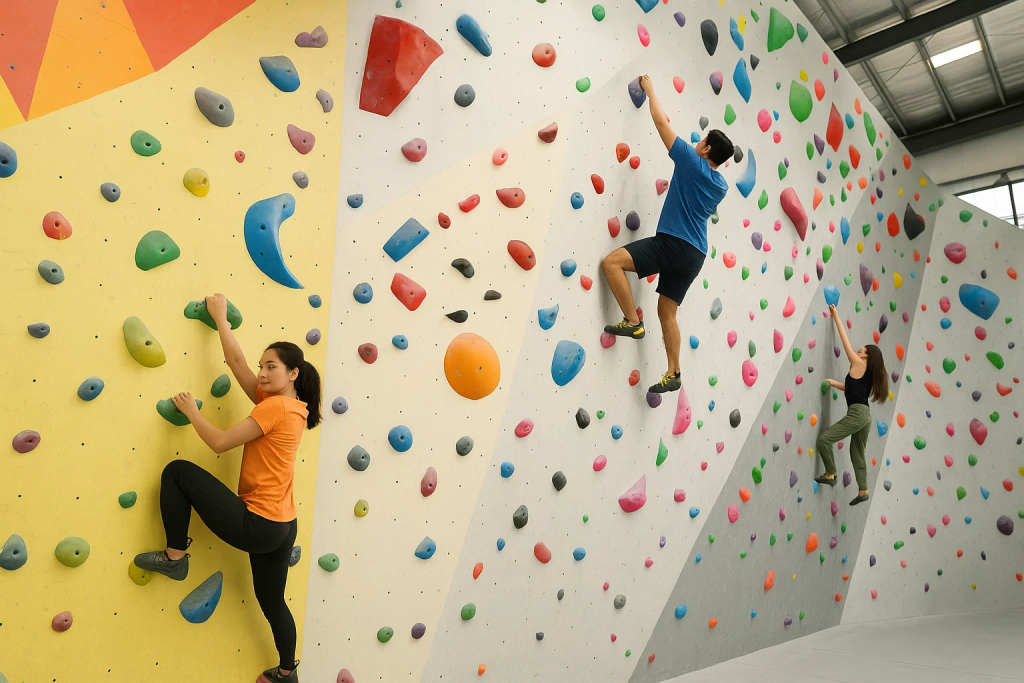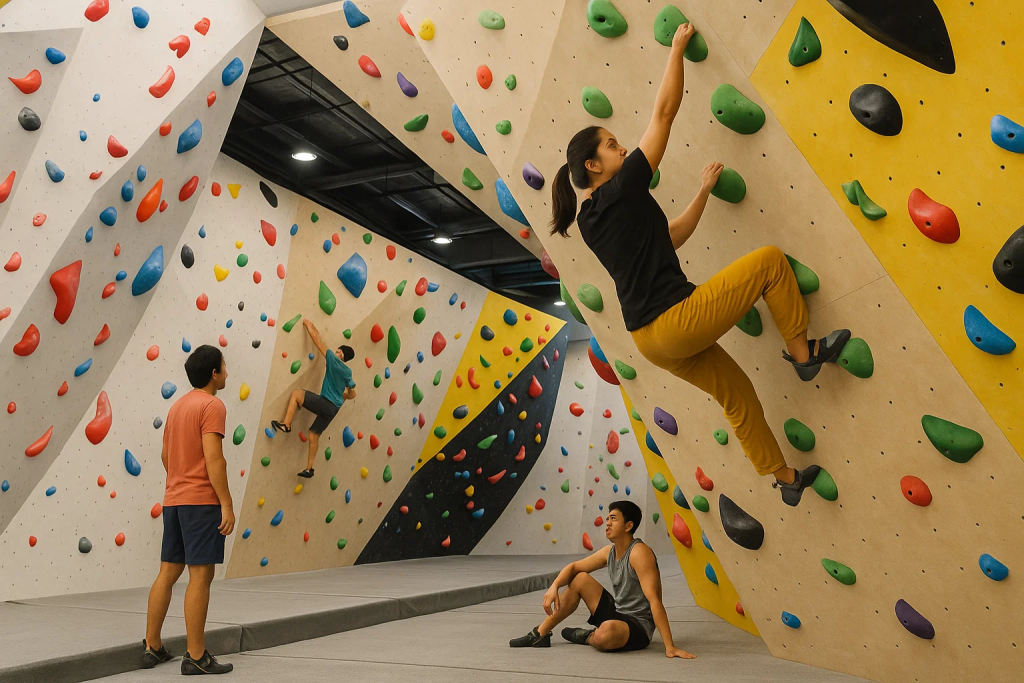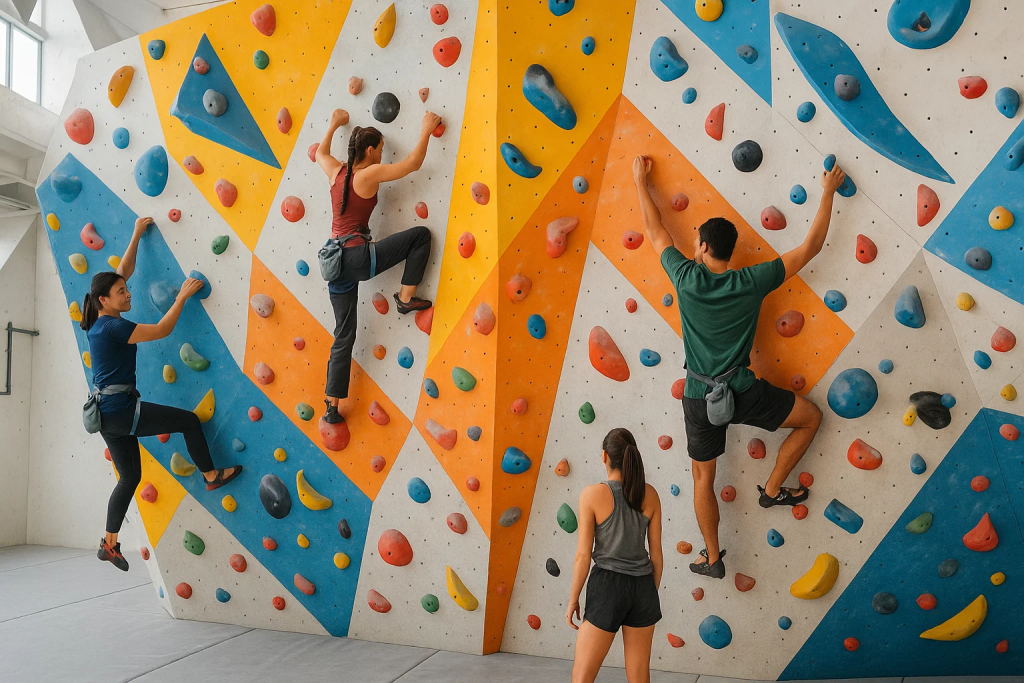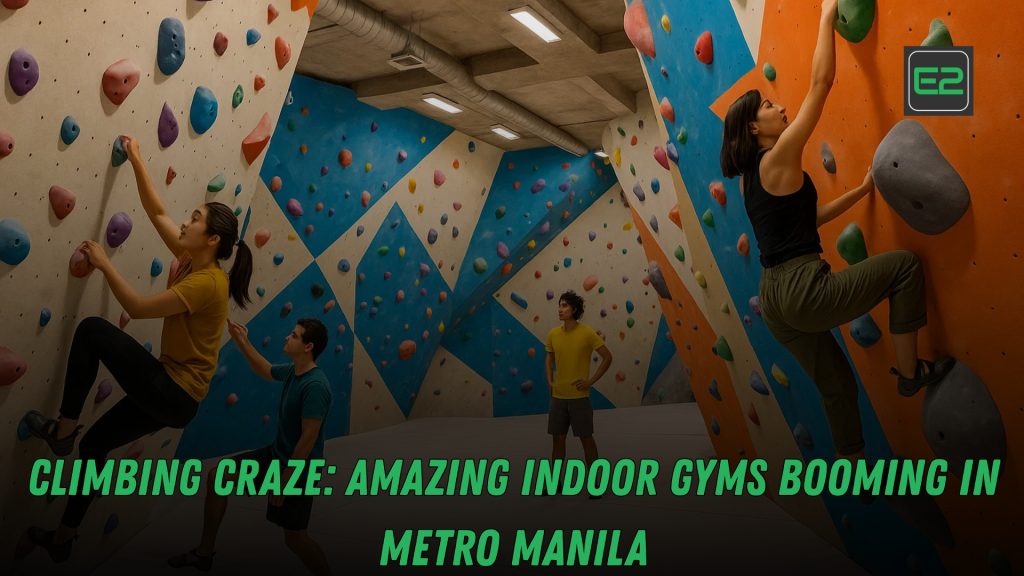Table of Contents
TL;DR
- Indoor climbing and bouldering are surging across Metro Manila, led by modern facilities such as Climb Central Manila (Mandaluyong), The Bouldering Hive (Makati & Greenhills), and Power Up (multiple branches, the scene’s pioneer).
- Beginners can start with first-timer classes, day passes, and gear rentals—no experience required.
- Expect a supportive culture, clear safety systems, and options to progress from bouldering (no rope) to top-rope and lead.
- This guide covers what to bring, typical costs, how to choose a gym, training tips, injury prevention, and a 12-week starter plan—plus a strong call-to-action and FAQs.

From Niche to Next Big Thing
The Manila scene now includes beginner-friendly gym, boutique bouldering spaces, and pioneers that shaped Philippine climbing culture. Below, we unpack the landscape, walk you through your first visit, and show you how to progress safely.
If you’ve seen more chalky hands around Mandaluyong, Makati, San Juan, or Quezon City lately, you’re not imagining it. Indoor climbing—from bouldering on low walls with crash pads to rope climbing that builds endurance—has shifted from niche hobby to mainstream fitness in Metro Manila. The appeal is obvious:
- It’s fun and social (you “project” routes with friends).
- It’s scalable (gyms grade climbs for every level).
- It’s time-efficient (a fulfilling session in 60–90 minutes).
- It delivers full-body strength, mobility, and problem-solving in one workout.
The Manila Landscape: Who’s Who & Where to Climb
Climb Central Manila (Mandaluyong)
Set in Greenfield District, Climb Central Manila bills itself as the largest indoor air-conditioned sport-climbing venue in the Philippines, with hundreds of square meters of wall space and beginner-friendly programming. Regular opening hours typically run Weekdays 1PM–10PM; Weekends/Holidays 10AM–10PM (always check before you go).
Why people love it
- Broad variety of top-rope and lead routes plus bouldering—great for mixed groups.
- Clear first-timer flow (waivers, safety briefing, gear rental).
- Location near EDSA and transit; plenty of food options post-climb.
The Bouldering Hive (Makati & Greenhills)
The Bouldering Hive (TBH) focuses on bouldering—short climbs without ropes, protected by thick pads. TBH operates in Circuit Makati and Greenhills, and advertises daily hours 10AM–10PM on its channels.
Why people love it
- Strong community vibe: route-setting variety, social sessions, cozy lounge and coffee.
- Beginner-to-advanced circuits that reward persistence over sheer strength.
- Convenient urban locations with mall or lifestyle-center amenities.
Power Up (Tandang Sora & other branches)
Power Up is widely regarded by local climbers as an OG pioneer—Tandang Sora is often cited as one of the first dedicated climbing facilities in the country, and the brand has had multiple outposts around the metro over the years.
Why people love it
- Authentic, grassroots ethos that produced generations of Filipino climbers.
- Mix of top-rope, bouldering, moonboard, and training walls (branch-dependent).
- Affordable training options and community coaching.
Tip: Schedules, route sets, and access policies can change with events and maintenance. Always check each gym’s latest hours and updates before you go.
Bouldering vs. Rope Climbing: Which One Should You Try First?
Bouldering
- Height: ~4–5 meters.
- Protection: Thick pads on the floor; no harness or belayer needed.
- Feel: Short, powerful “problems” that emphasize coordination and technique.
- Best for: Quick sessions, social learning, and first-timers who want to start immediately.
Top-rope
- Height: 8–15+ meters (gym-dependent).
- Protection: Rope already runs through an anchor at the top; a belayer controls slack.
- Feel: Endurance-oriented, steady technique, confidence at height.
- Best for: Beginners with a friend or class who want controlled exposure to height.
Lead climbing (intermediate)
- Height: Similar to top-rope; you clip quickdraws as you climb.
- Feel: More mental focus, efficient clipping, fall-management awareness.
- Best for: Climbers who’ve mastered belay skills and want the next challenge.
Most Manila gyms support bouldering + rope to varying degrees, so you can progress fluidly within one membership.
Your First Visit: What to Expect Step-by-Step
- Sign the waiver & watch a briefing. Staff will explain rules, fall zones (for bouldering), and belay safety (for rope).
- Rent gear (if needed): climbing shoes, chalk, and—if rope climbing—harness and belay device.
- Warm up: easy traverses on the wall, forearm and shoulder mobility, gentle hip openers.
- Start easy: pick the lowest grades; success builds technique and confidence.
- Rest properly: 1–3 minutes between boulders; 5–8 minutes between hard attempts.
- Log a win: send a beginner circuit or finish a top-rope route clean.
- Cool down and wash hands (chalk + Manila commute grime is a combo!). Hydrate.
Safety & Etiquette—The Manila Way
- Share the wall: Don’t stand under someone who’s climbing; wait your turn.
- Mind fall zones: Step back from pads when someone is on a boulder.
- Communicate clearly: “Climbing!” / “Off!” / “Below!” / “Falling!”
- Belay like a pro: Take a class; keep brake hand on the rope at all times.
- Keep holds clean: Light chalk; brush holds after attempts.
- Be kind to beginners: We all started at V0 / 5.6 once.
Cost & Value: How Much to Budget (and Save)
Prices vary by gym and promotions; use this as a planning framework rather than exact quotes.
- Day pass: Typically the best option for first visits; gear rental often available on-site (first-come, first-served during peak hours).
- Multi-visit packs / memberships: Good if you’ll climb 2–3x per week.
- First-timer classes: Bundle of instruction + day pass + rentals.
- Student or off-peak rates: Ask! Many gyms run weekday afternoon promos.
- Gear path: Rent first → buy shoes when you’re consistent → consider a chalk bag → harness/belay device if you love ropes.
Savings hacks
- Go off-peak (weekday afternoons) for calmer walls and shorter queues.
- Split coaching costs with a friend.
- Watch for intro packs on gym socials, ClassPass deals for bouldering sessions, and event nights with discounted entries.
How to Choose the Right Gym (and Stick With It)
- Location & commute: Your best gym is the one you’ll visit. Greenfield District (Mandaluyong), Circuit Makati, and Greenhills are well-situated for many.
- Style mix: If you want to try everything (boulder + rope + lead), gravitate to full-service facilities. If you prefer compact, social sessions, bouldering-focused gyms shine.
- Community fit: Check if the gym vibe (music volume, coaching style, crowd age) matches your motivation.
- Classes & setting: Ask about first-timer clinics, belay certs, youth programs, and women’s nights.
- Route-setting quality: Variety in hold styles, angle changes, and grade spread keeps you progressing.
Training: From Zero to “Send It” (Without Getting Hurt)
The 3-2-1 Rule for Beginners (Weeks 1–4)
- 3 climbs per week (2 bouldering + 1 rope, or vice versa).
- 2 strength or mobility mini-sessions (20–30 min at home): shoulder stability, hips, core.
- 1 full rest day (no climbing or heavy pulling).
Warm-up routine (10–12 min)
- 3–5 min easy traverse or treadmill bike.
- Shoulder circles, band pull-aparts, scapular shrugs.
- Forearm extensor work (rubber band opens), wrist circles.
- Hip openers: world’s greatest stretch, Cossack squats.
- 2–3 easy problems or a 5.6/5.7 top-rope.
Post-session
- 5–10 min gentle mobility; rehydrate; protein + carbs within 45–60 minutes.

Weeks 5–8: Build Technique, Not Just Power
- Add a footwork day: climb easy problems quiet feet only (no thuds).
- Practice route-reading: visualize hand/foot sequence before starting.
- Start a hangboard only if a coach says your tendons are ready (usually after 3–6 months of regular climbing).
Weeks 9–12: Project & Consolidate
- Pick one boulder and one route slightly above your current level.
- Film attempts to spot mistakes (hips too far, late foot moves).
- Add light antagonist training (push-ups, face-pulls) to balance pulling volume.
Injury Prevention: Keep Tendons Happy in the Tropics
- Progress gradually: Grades are guidelines, not goals. Earn consistency before leveling up.
- Respect tendons: Finger flexors adapt slower than muscles; avoid “crimping” hard in month one.
- Use open-hand grips on steep holds.
- Hydrate + salt during Manila’s hottest months (electrolytes on long sessions).
- Deload week every 4–6 weeks—climb half volume at easy grades.
- Any sharp pain in fingers, elbows, or shoulders? Stop and see a qualified clinician.
Culture & Community: Why People Stick Around
Climbing in Manila is collaborative: strangers spot beta, coaches offer micro-tweaks, and route-setters celebrate your send. You’re joining a supportive micro-culture where PRs are personal and shared. Follow gyms on Instagram/Facebook for comp nights, socials, women’s sessions, youth classes, and route-set updates. Facebook+1Instagram
Manila Gym Snapshots (At a Glance)
Always verify live details with each gym. This snapshot reflects publicly posted information and community directories.
- Climb Central Manila — Mandaluyong (Greenfield District)
Good for: full spectrum (boulder + top-rope + lead), big-group intros, families.
Typical hours: Weekdays 1–10PM; Weekends/Holidays 10AM–10PM. - The Bouldering Hive — Makati (Circuit) & Greenhills (GH Mall)
Good for: focused bouldering sessions, social vibe, coffee + climb.
Typical hours: Open daily 10AM–10PM. - Power Up — Tandang Sora (and other branches)
Good for: authentic training, top-rope + boulder + moonboard (location-dependent); a true pioneer. - Other mentions & roundups: Community lists often include The Edge Climb Gym (Upper Deck) and more; see Manila-focused roundups for ideas and current reopenings.
What to Bring on Day One (Beginner Packing List)
- Flexible workout clothes (long shorts/leggings to avoid pad rash).
- Thin socks (if renting shoes).
- Water bottle + small snacks (banana, trail mix).
- Chalk (if you have it—gyms often sell liquid or loose chalk).
- Hair ties; tape for calluses; a small towel.
- A friend—more fun, and you can belay each other in rope sessions.
Manila Climbing for Kids, Teens, & Families
Many gyms host youth classes, weekend clinics, and school field trips with safe progressions and kid-scaled problems. Ask about:
- Age policies and guardian requirements.
- Rental sizes for smaller feet + harnesses.
- Birthday party packages with instructor support.
Climbing can be a confidence engine for kids—problem-solving, resilience, and respectful risk-taking in a padded, controlled environment.
Sustainable Climbing: Etiquette Beyond the Gym
- Use reusable bottles; refill at gym fountains.
- Brush holds and keep chalk tidy; your lungs (and others’) will thank you.
- Support local route-setters and employees—say thanks, give feedback politely.
- If you transition to outdoor crags, join cleanups, learn Leave No Trace, and hire local guides.
12-Week Manila Starter Plan (Printable)
Weeks 1–4
- 2 bouldering + 1 rope session weekly.
- Learn falling technique on boulders (land on both feet, roll).
- Take a belay class; practice under supervision.
Weeks 5–8
- Add footwork-only sessions and quiet-feet drills.
- Try easy overhangs for core tension; keep intensity moderate.
- Start a training log (wins, fails, rest, hydration).
Weeks 9–12
- Pick one project above your comfort grade; work it twice a week.
- Learn simple antagonist work: push-ups, band face-pulls, wrist extensor lifts.
- Consider buying your first pair of shoes if you’re climbing 2–3x/week consistently.
Strong Call-to-Action
Ready to try climbing in Metro Manila?
- Pick a location near you—Mandaluyong (Climb Central), Circuit Makati/Greenhills (Bouldering Hive), or Tandang Sora (Power Up)—and book a first-timer session or walk in during off-peak hours.
- Comment “SEND THE STARTER PACK” and I’ll share a printable first-visit checklist, 12-week plan, and a beginner gear guide you can bring to the gym.
- Post your first send (route/problem) and tag your gym—celebrate progress, not perfection!

Frequently Asked Questions (FAQ)
1) I’ve never climbed. Which Manila gym is best for absolute beginners?
2) Do I need to be strong to begin?
No. Climbing is technique-first. You’ll learn footwork, balance, and body positioning. Strength comes naturally as you practice, and beginner grades are designed for first-timers.
3) What should I wear and bring?
Flexible clothes, thin socks (if renting shoes), water, a small snack, and a hair tie if needed. Most gyms rent shoes and chalk; buy gear only after you’re consistent.
4) Is indoor climbing safe?
Gyms follow strict safety systems: fall-zone etiquette for bouldering, belay checks for ropes, staff supervision, and clear rules. Take a belay class, learn to fall properly, and progress gradually.
5) How often should I climb to improve?
Start with 2–3 times per week, plus 1–2 short mobility/strength minis. Log your sessions, rest when fingers or elbows feel achy, and add difficulty slowly—your tendons adapt more slowly than muscles.
Sources & Further Reading
- Climb Central Manila — venue overview & opening hours (Greenfield District, Mandaluyong). Climb Central+1
- The Bouldering Hive — locations in Circuit Makati & Greenhills; sample hours and amenities. Bouldering HiveInstagramClassPass
- Power Up — pioneer gym; Tandang Sora background; training wall mix (directory). Adrenaline RomanceClimb Philippines
- Roundups/Lists — Manila gyms and reopenings overview. Klook Travel
Final Word:
Indoor climbing in Metro Manila isn’t just a fad; it’s a community movement. With accessible gyms, friendly coaching, and routes for every level, there’s never been a better time to join. Start small, be consistent, and watch your strength—and confidence—climb.
Indoor climbing is booming across Metro Manila, with accessible, air-conditioned venues and a welcoming culture turning first-timers into regulars. The scene’s anchors include Climb Central Manila in Mandaluyong (full spectrum: bouldering, top-rope, lead), The Bouldering Hive in Circuit Makati and Greenhills (focused bouldering with a social vibe), and pioneer Power Up (Tandang Sora), known for grassroots training walls.
Beginners can start immediately: sign a waiver, rent shoes (and harness/belay device for ropes), warm up, choose the lowest grades, rest between tries, and cool down. Understand formats: bouldering is short, powerful climbing on low walls with pads; top-rope builds height confidence with a belayer; lead is the next step for experienced climbers who clip as they ascend.
Safety and etiquette matter—respect fall zones, communicate (“Climbing!” “Below!”), keep a brake hand on the rope, use chalk lightly, brush holds, and give beginners space. Budget with day passes, intro classes, gear rentals, and look for off-peak or student promos; buy shoes once you climb 2–3× weekly. Choose a gym by commute, style mix, classes (first-timer clinics, belay certs, youth/women’s sessions), and route-setting quality.
For progress without injury, follow a 12-week starter plan: climb 2–3×/week, add short mobility/strength minis, focus on footwork and route-reading, and advance gradually. Protect tendons (favor open-hand grips early, hydrate with electrolytes in Manila heat, take deload weeks).
Beyond fitness, the community—events, comps, coffee corners—keeps people coming back. Call to action: pick the nearest gym, book a first-timer session, and ask for the printable starter pack (checklist + 12-week plan + gear guide) to send your first route with confidence.
